Table of Contents
Introduction
The most significant pain point of managing remote/hybrid teams is the inability to track working hours accurately. You aren’t alone if you’re facing this conflict. According to Gartner, 45% of companies with teams working in hybrid mode face this conflict.
Keeping a consistent eye on all tasks could lead to micromanagement and demotivation of employees, but losing an additional budget isn’t beneficial for the business. This often makes remote team management a hassle, right?
That’s where organizations turn to time-tracking software. It is a boon of technology that aligns time management, attendance management, tracking hours worked, and much more.
So, explore the top 9 tools for reducing time theft and gathering essential data for hybrid teams for better collaboration.
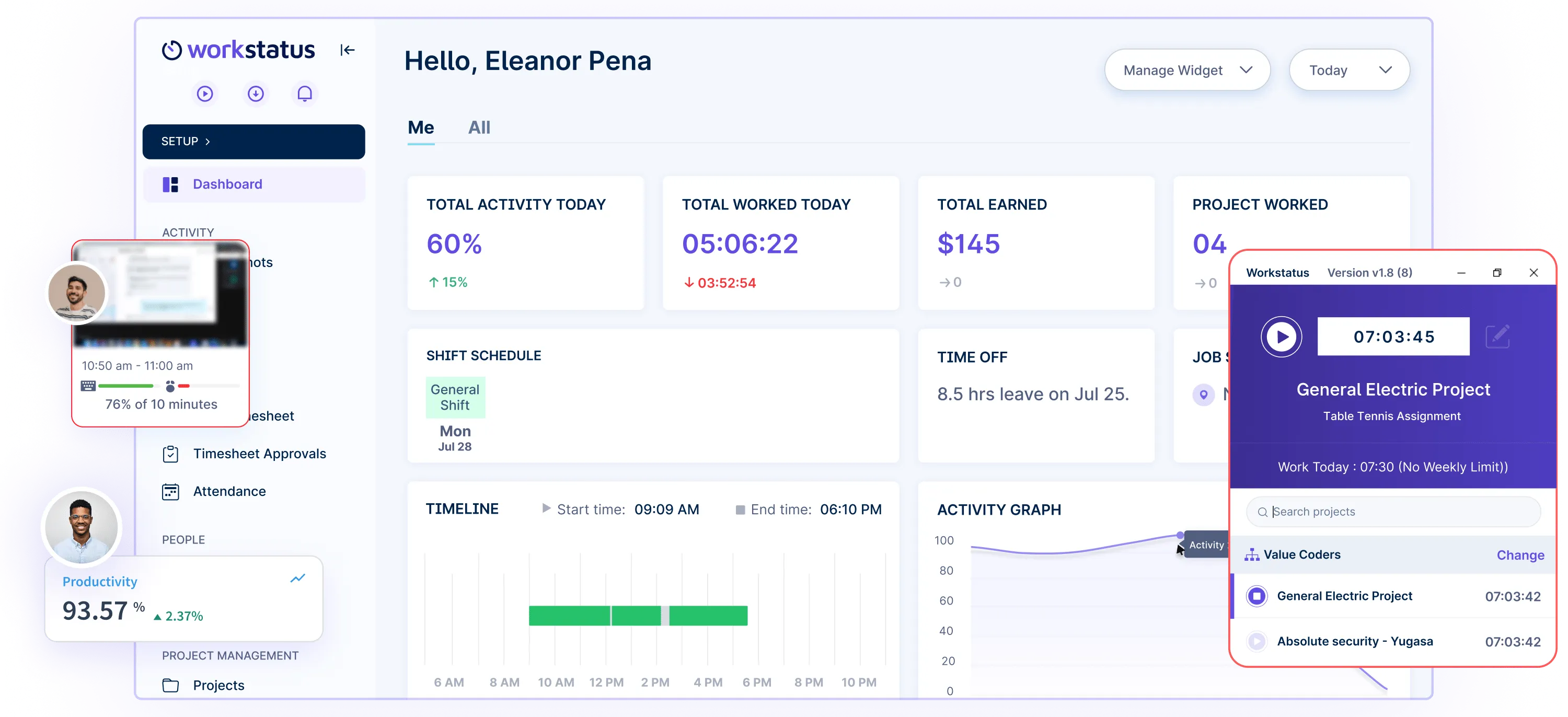 This blog post will explain how idle time tracking works and introduce you to nine excellent software platforms that automatically collect this data.
This blog post will explain how idle time tracking works and introduce you to nine excellent software platforms that automatically collect this data.
This way, you can empower your team to work smarter and more efficiently.
Let’s dive in:
What is idle time tracking?
Idle time tracking is a crucial component of workforce management and productivity optimization. It involves monitoring and recording periods when employees are not actively engaged in productive tasks or work-related activities.
This concept serves several purposes in the workplace, contributing to better resource utilization, efficiency improvement, and cost reduction.
Elements of Idle Time Tracking Software Tools
Here are some key elements of any idle time tracking tool.
1. Monitoring Tools
These are software or applications that help managers and employers keep track of when employees are not actively engaged in work.
These tools can include time tracking software, productivity monitoring tools, or specific idle time tracking applications.
2. Data Collection
Data collection involves gathering information on periods of inactivity or non-productive time, such as breaks, distractions, or technical issues that may lead to decreased productivity.
This data helps in identifying trends and patterns that can be used to improve overall workflow efficiency.
3. Analysis
After data collection, the next step is to analyze the information to understand the root causes of idle time.
This analysis helps in identifying specific areas where improvements can be made, such as optimizing work processes, providing additional training, or addressing potential distractions in the work environment.
4. Reporting
Reporting involves summarizing the analyzed data into comprehensive reports that highlight the insights and findings related to idle time.
These reports can be used to communicate the impact of idle time on overall productivity and to share recommendations for enhancing employee engagement and reducing unproductive hours.
5. Implementation of Solutions
Based on the insights gained from the analysis and reporting, organizations can implement targeted solutions to minimize idle time.
It may involve introducing new work policies, providing additional resources or training to employees, or optimizing work schedules to better align with employee productivity levels.
6. Feedback and Adjustment
Seeking feedback from employees about the effectiveness of the idle time tracking process is crucial.
This feedback helps in understanding the practical implications of the implemented solutions and allows for necessary adjustments to be made to the tracking process, ensuring it remains relevant and beneficial for both employees and the organization as a whole.
Top 5 Benefits of Idle Time Tracking
Here are the five major benefits of tracking idle time at the workplace.
1. Identification of Unproductive Periods
Idle time tracking helps pinpoint moments when employees are not actively contributing to their tasks or projects, which can include:
- Waiting for approvals from supervisors or clients, leading to work delays
- System downtime, causing interruptions in the workflow and hindering progress
- Breaks between assignments or tasks, resulting in potential gaps in productivity and work momentum
By identifying these unproductive periods, organizations can take proactive steps to minimize such instances and ensure smoother workflow continuity.
2. Resource Allocation
By understanding when and why idle time occurs, organizations can allocate resources more effectively. This may involve:
- Reassigning tasks during downtime to ensure that employees remain productive and engaged
- Streamlining workflows and task assignments to reduce idle periods and optimize resource utilization
Efficient resource allocation based on idle time insights can lead to improved overall operational efficiency and task management.
3. Productivity Analysis
Tracking idle time allows businesses to conduct a comprehensive analysis of efficiency and productivity. This analysis can help:
- Identify bottlenecks within workflows that contribute to idle time, allowing for targeted process improvements
- Recognize inefficiencies or unproductive processes that may require reevaluation or optimization to enhance overall productivity levels
By conducting a thorough productivity analysis, organizations can implement strategic changes to enhance overall workflow efficiency and productivity.
4. Employee Engagement
Proactively addressing idle time can significantly improve employee engagement and satisfaction. This proactive approach enables managers to:
- Provide additional training or resources to help employees stay motivated and engaged during their work hours
- Offer necessary support and guidance to ensure employees feel valued and supported in their roles
Enhanced employee engagement through the management of idle time can lead to a more positive work environment and increased employee satisfaction.
5. Cost Reduction
Reducing idle time directly contributes to cost savings for organizations. This is because
- Minimizing unproductive hours translates to increased output and improved efficiency, leading to potential reductions in overall labor costs and operational expenses
By effectively managing and reducing idle time, businesses can achieve significant cost savings and optimize their budget allocation for increased profitability.
At last, idle time tracking provides valuable insights for businesses to optimize their operations, reduce inefficiencies, and ultimately achieve higher levels of productivity and profitability.
Top 9 Tools for Tracking Idle Time in Hybrid Teams
Here is a list of the top nine tools for idle time tracking of hybrid teams.
1. Workstatus
Workstatus is a user-friendly time tracking and productivity tool designed to make managing your team’s work easier. With Workstatus, you can effortlessly monitor attendance, track tasks, and gain valuable insights to enhance productivity.
Here’s what you will get:
Easy Monitoring: Workstatus automatically tracks employee attendance and activity, eliminating the need for manual tracking. It provides a clear picture of who’s working on what.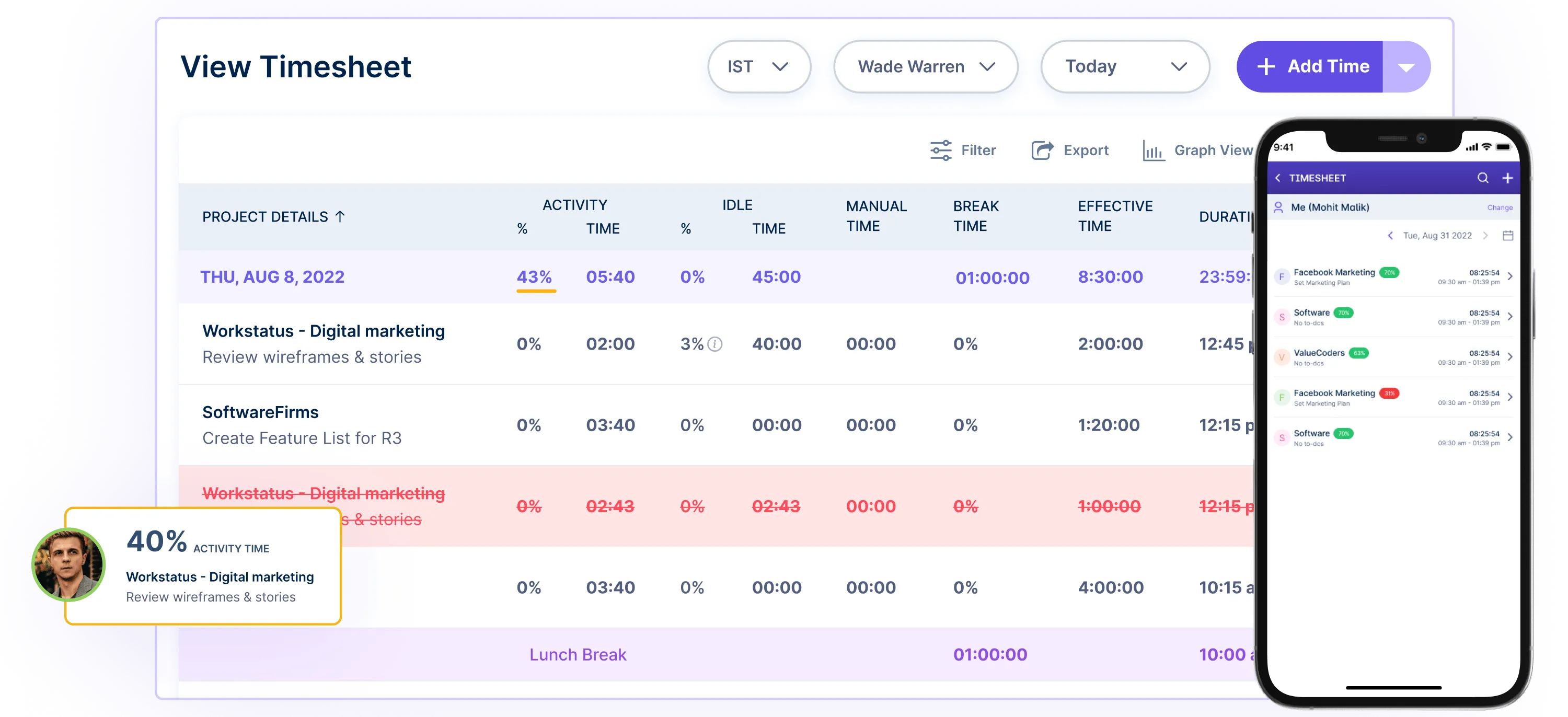 Detailed Reports: With the Activity Summary report, you can dive deep into specific projects, tasks, websites, and apps employees use during work hours. This data helps you optimize workflows and identify areas for improvement.
Detailed Reports: With the Activity Summary report, you can dive deep into specific projects, tasks, websites, and apps employees use during work hours. This data helps you optimize workflows and identify areas for improvement.
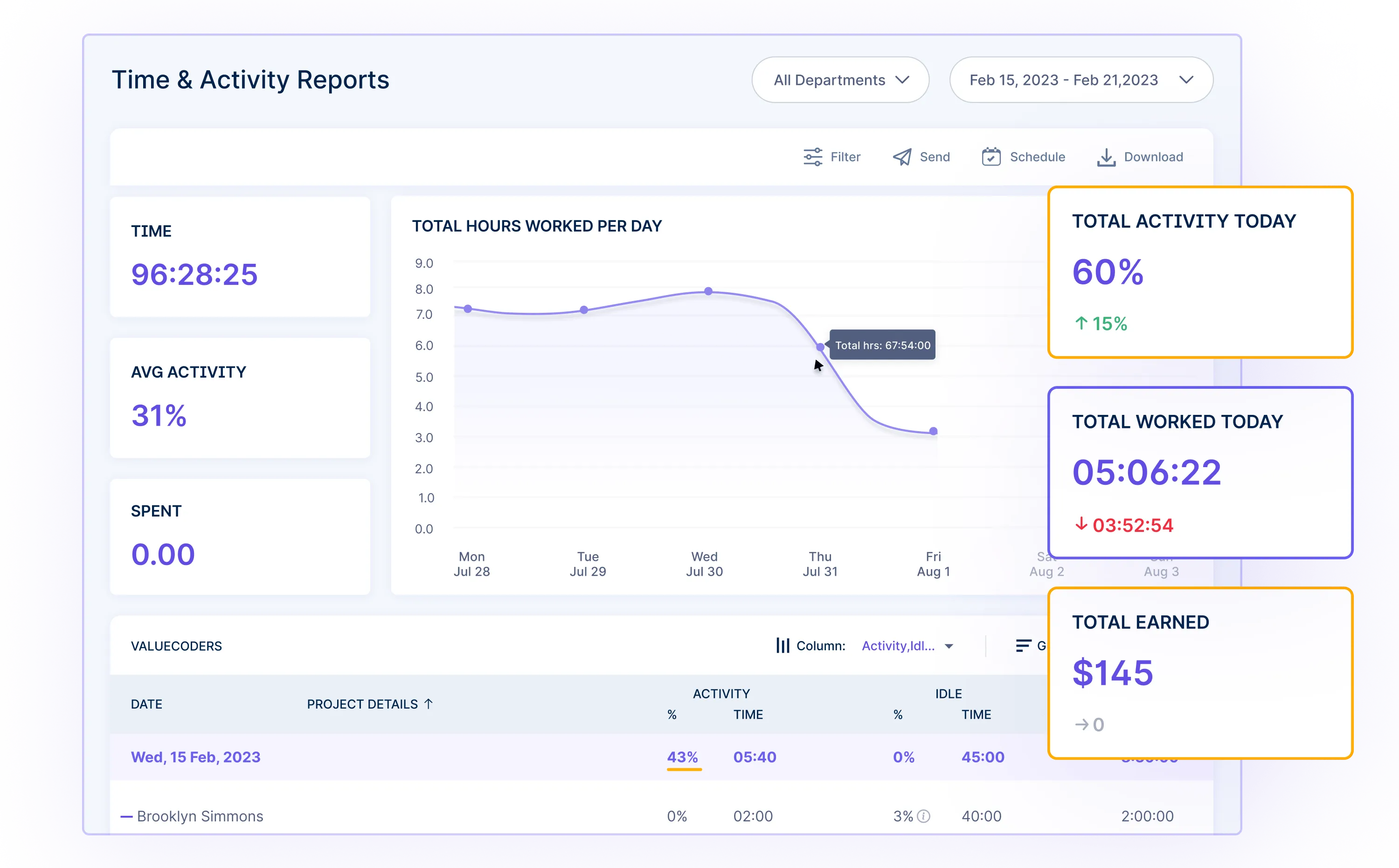
Identify Idle Time: Understanding idle time for different job roles allows you to analyze productivity differences. You can uncover whether some employees are less active during certain tasks and use this insight to improve processes.
 Proactive Problem Solving: You can take action when needed by analyzing idle time. For instance, if a team member has excessive idle time, you can analyze the time spent on apps they use and ensure they have the right tools for their role. You can also assess why they have numerous meetings and whether they are necessary.
Proactive Problem Solving: You can take action when needed by analyzing idle time. For instance, if a team member has excessive idle time, you can analyze the time spent on apps they use and ensure they have the right tools for their role. You can also assess why they have numerous meetings and whether they are necessary.
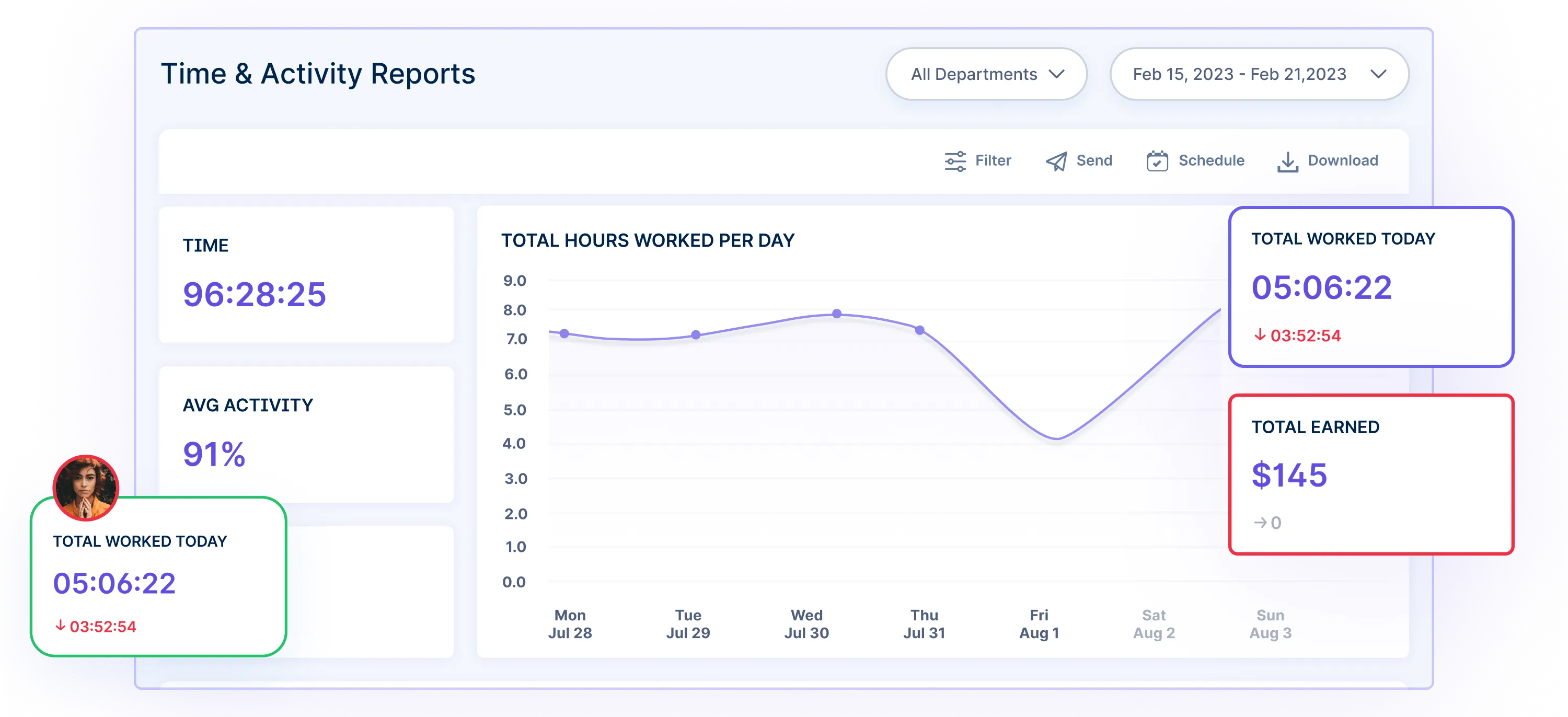
Screen Visibility: Workstatus offers activity screenshots, providing a visual record of employees’ actions. It helps you ensure that processes are followed correctly and can highlight the need for additional training when necessary.
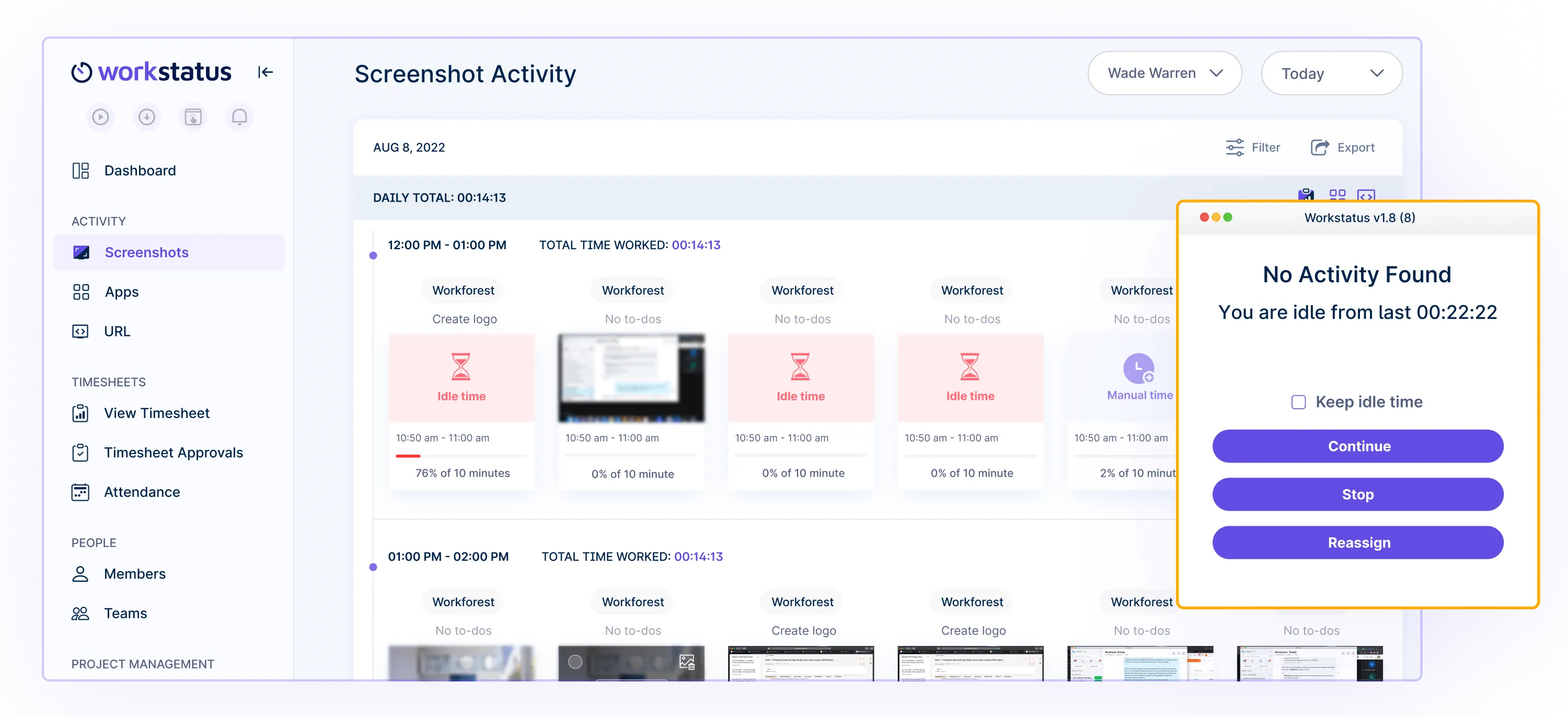
Workstatus is the tool to streamline your team’s work, boost productivity, and make data-driven decisions to improve your processes.
Major Benefits:
- Streamlines idle time tracking for hybrid teams
- Enhances team productivity with real-time insights
- Offers customizable reports to optimize workflows
2. Time Doctor
Time Doctor is a versatile tool that automatically tracks employee attendance and activity. It provides internet usage insights, task management, and productivity reports to help teams work more efficiently.
Features like the Activity Summary report and idle time analysis make it an excellent choice for hybrid teams seeking to optimize their workflows.
Major Benefits:
- Automatically monitors employee attendance and activity
- Provides internet usage insights for efficient time management
- Offers task tracking and productivity reports
3. Traqq

Traqq offers easy-to-use time tracking and productivity monitoring. It helps hybrid teams stay organized and productive by providing real-time insights into work activities.
Traqq is known for its user-friendly interface, making it a great choice for teams looking to monitor idle time and improve remote and office-based work.
Major Benefits:
- Easy-to-use time tracking and productivity monitoring
- Real-time insights to boost team organization and productivity
- User-friendly interface for efficient idle time tracking
4. timeTracko

timeTracko is a reliable tool for tracking time and attendance in hybrid teams. It offers features like timesheet management, task tracking, and detailed reports.
It’s designed to boost productivity by giving managers insights into how their team members spend their time in the office and remotely.
Major Benefits:
- Reliable time and attendance tracking for hybrid teams
- Timesheet management and detailed reporting
- Helps improve productivity with insights into work hours
5. CurrentWare
CurrentWare is a comprehensive solution that includes idle time tracking as part of its features. It helps hybrid teams manage internet usage, monitor computer activities, and improve productivity.
CurrentWare offers various tools for tracking idle time and ensuring team members are engaged in productive work.
Major Benefits:
- Comprehensive solution for monitoring idle time and productivity
- Manages internet usage and computer activities
- Tools for tracking idle time and ensuring productive work
6. Teramind

Teramind is a robust employee monitoring tool that helps hybrid teams optimize workflows. It provides real-time activity tracking, idle time analysis, and user behavior analytics.
Teramind’s advanced features suit organizations looking to enhance productivity and data security.
Major Benefits:
- Robust employee monitoring with real-time activity tracking
- Advanced idle time analysis and user behavior insights
- Enhances productivity and data security for hybrid teams
7. Monitask
Monitask is a simple and effective time tracking tool for hybrid teams. It automatically monitors employee activity, tracks work hours, and provides insights into productivity.
Monitask’s straightforward interface and idle time tracking capabilities make it a valuable tool for teams seeking to maximize efficiency.
Major Benefits:
- Simple and effective time tracking for improved productivity
- Automatically monitors employee activity and work hours
- Provides insights into productivity with a user-friendly interface
8. InterGuard
InterGuard is a comprehensive employee monitoring solution that includes idle time tracking. It offers screen capture, monitoring of internet usage, and application tracking.
InterGuard is suitable for hybrid teams looking to improve productivity and security.
Major Benefits:
- Comprehensive employee monitoring with idle time tracking
- Screen capture, internet usage monitoring, and app tracking
- Improves productivity and security for hybrid teams
9. Insightful

Insightful is a user-friendly idle time tracking tool that helps hybrid teams stay on top of their work. It offers insights into computer usage, internet activity, and productivity trends.
Insightful empowers teams to work smarter and make data-driven decisions to enhance performance.
Major Benefits:
- User-friendly idle time tracking tool for hybrid teams
- Offers insights into computer usage and internet activity
- Empowers teams to work smarter with data-driven decision-making
Factors to Consider Before Investing in Idle Time Tracker
Here are six key factors to consider before investing in an idle time tracker:
1. Relevance: Ensure that the features of the idle time tracker align with your team’s specific needs. Consider whether it provides insights that will genuinely enhance productivity and efficiency in your work environment.
2. Ease of Use: Choose a user-friendly idle time tracker that is intuitive and easy for your team to navigate. It should not require extensive training or cause additional stress for your employees.
3. Compatibility: Verify that the idle time tracker integrates with your existing systems and tools. It should not disrupt your current workflow but complement it to improve overall efficiency.
4. Data Privacy: Prioritize protecting your team’s privacy by selecting an idle time tracker that complies with data protection regulations. Ensure that the tool maintains the confidentiality of sensitive information and does not compromise your team’s data.
5. Costs: Evaluate the cost of the idle time tracker about its potential benefits for your team. Consider the return on investment and determine whether the tool’s features justify its price and fit within your budget.
6. Support and Updates: Choose a provider that offers reliable customer support to address any issues or concerns that may arise while using the idle time tracker. Additionally, opt for a tool that receives regular updates and improvements to ensure its functionality remains up to date and meets your evolving business needs.
Closing Thoughts
In conclusion, keeping track of idle time in hybrid teams is crucial for maintaining productivity and efficiency.
With the right tools, such as Workstatus, managers can effectively monitor employee activity and address any issues promptly.
By leveraging these tools, you can create a more streamlined and accountable work environment, fostering better collaboration and communication among both remote and in-office team members.
Tracking idle time not only helps in optimizing work hours but also contributes to a more balanced and productive work culture, ultimately leading to improved performance and job satisfaction within the hybrid team setup.












